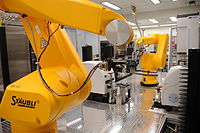
Photo from wikipedia
The present study adapted an existing high content imaging-based high-throughput phenotypic profiling (HTPP) assay known as "Cell Painting" for bioactivity screening of environmental chemicals. This assay uses a combination of… Click to show full abstract
The present study adapted an existing high content imaging-based high-throughput phenotypic profiling (HTPP) assay known as "Cell Painting" for bioactivity screening of environmental chemicals. This assay uses a combination of fluorescent probes to label a variety of organelles and measures a large number of phenotypic features at the single cell level in order to detect chemical-induced changes in cell morphology. First, a small set of candidate phenotypic reference chemicals (n = 14) known to produce changes in the cellular morphology of U-2 OS cells were identified and screened at multiple time points in concentration-response format. Many of these chemicals produced distinct cellular phenotypes that were qualitatively similar to those previously described in the literature. A novel workflow for phenotypic feature extraction, concentration-response modeling and determination of in vitro thresholds for chemical bioactivity was developed. Subsequently, a set of 462 chemicals from the ToxCast library were screened in concentration-response mode. Bioactivity thresholds were calculated and converted to administered equivalent doses (AEDs) using reverse dosimetry. AEDs were then compared to effect values from mammalian toxicity studies. In many instances (68%), the HTPP-derived AEDs were either more conservative than or comparable to the in vivo effect values. Overall, we conclude that the HTPP assay can be used as an efficient, cost-effective and reproducible screening method for characterizing the biological activity and potency of environmental chemicals for potential use in in vitro-based safety assessments.
Journal Title: Toxicology and applied pharmacology
Year Published: 2019
Link to full text (if available)
Share on Social Media: Sign Up to like & get
recommendations!